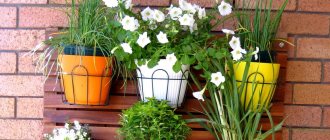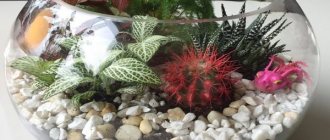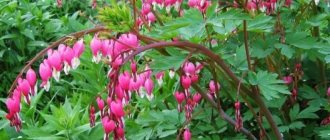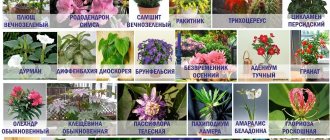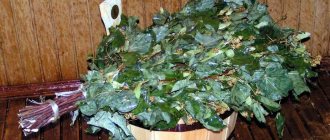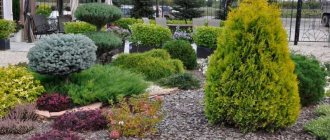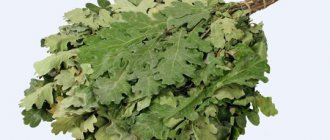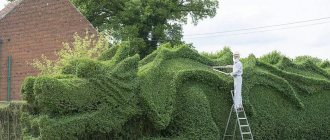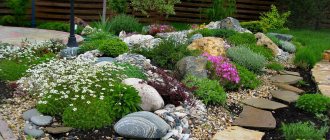Landscape design masters recommend planning plantings along the fence at the initial stage of the construction process. In this case, by the time of settlement, the territory will acquire a lived-in appearance and fill the space with the beauty of flowering plantings. But it’s never too late to improve your suburban area. We will consider the question of which trees are preferable to plant along the fence in detail.
Planning nuances
Before starting the landscaping process, an inspection of the area to be transformed is carried out. When selecting plantings to decorate the space along the fence at the dacha, it is important to evaluate and skillfully use the positive aspects.
Planted trees must skillfully mask the negative aspects if they cannot be eliminated. To correctly determine which trees are best to choose for decorating a fence, you need to clarify a number of questions:
- Purpose of trees and shrubs. Will it be an additional decoration planted along a beautiful fence, or will the planting be carried out in order to hide the existing defects and shortcomings of the site.
- The area of land allocated for trees. Do not unnecessarily overload the area with tall and large plantings; this can visually reduce the internal space.
- Soil characteristics. Trees differ in their growing conditions, so care must be taken to create a comfortable environment for them.
- Degree of illumination. This affects the decision on which side of the fence to plant on. Advice! Behind a high continuous fence, plant shade-tolerant trees that do not need a lot of direct sun.
- Possibility of aftercare. If you plan regular and thorough care, you can choose decorative plantings that require increased attention. If you don’t have enough free time, opt for unpretentious specimens.
There are two directions when designing a site along a fence:
- The landscape is as close as possible to natural growth, where low-growing plantings are mixed with tall plantings. This option is good for uneven terrain and can skillfully disguise the imperfections of the territory.
- Strict adherence to geometric shapes. The rows of trees are strictly calibrated, the plants are selected according to their height and form a well-groomed, complete composition.
A beautiful landscape appears in the photo with trees along the fence on the site:
Landscape Design Rules
When designing a flower bed along a fence, you should take into account important factors in choosing green spaces:
- Free area of land: for a small strip of soil, one type of small-sized plant is planted; for a long flowerbed about a meter wide, two or three varieties of flowers and shrubs are selected.
- Planting functionality: decorative, combined with the style of the fence, or practical purpose, designed to disguise the unsightly appearance of the fence, shading, hiding the territory from prying eyes.
- The height and material of the fence (chain-link mesh, wooden picket fence, corrugated board).
- Orientation of the fence to the cardinal points. Flora that is resistant to drought and direct sunlight is planted on the southern and western sides of the fence, and crops that can easily tolerate cold and wind are planted on the northern and eastern sides.
- Illumination of the flower bed near the fence during the day: choose light-loving, shade-loving or shade-tolerant plants. Shade-tolerant crops are those that thrive equally well in the shade and in direct sunlight.
- The plants have the same requirements for soil type, watering, and fertilizing.
- The growth rate and size of adult specimens, avoiding thickening of plantings and voids in them. It is recommended to plant no more than 3 tall, 6–7 medium-sized and up to ten low-growing plants per square meter.
- Features of planting care: unpretentious garden crops require less time to care for them.
Rabitz
The mesh is considered a fragile structure, so it is not advisable to load it with heavy plants. The transparency of the fence also poses a problem. Therefore, when choosing shrubs and trees, they focus on specimens that will hide the internal territory of the site from prying eyes and will not create unnecessary load on the structure.
The formation of hedges is the optimal solution to the problem. Typically, tall shrubs that do not need regular crown pruning are used for these purposes. It is good to plant along a transparent fence:
- unpretentious lilac;
- evergreen thuja;
- useful hawthorn or barberry;
- irgu;
- chokeberry.
The gap between the bush and the fence is about 1 m, the planting depth is over half a meter.
In addition to chain-link mesh, spectacular wrought-iron fences are also transparent. The plants presented in the following table will help you beautifully decorate the space along the fence:
Plants for planting from the inside
The area inside the yard is protected from the wind and the choice of plants for planting along the fence is very wide. Compositions of flowering plants, ornamental vines, deciduous and evergreen shrubs, selected taking into account the rules of landscape design, can turn even an unsightly fence into a work of art.
For vertical gardening of the fence on the side of the house, climbing roses, clematis, bindweed, ivy, and wisteria are used. Climbing plants that create a living curtain can be an independent element of fencing design and a backdrop for colorful beds of perennial and annual flowers.
Long ribbon flower beds, which combine flowers and shrubs, are perfect for decorating the landscape along the fence. For flower beds that bloom all summer, it is necessary to draw up a diagram that allows you to correctly arrange flowers according to flowering dates, select shades and calculate the required number of plants for planting.
Annual flowers for flower beds along the fence:
- shade-loving - begonia, saxifrage, balsam;
- shade-tolerant - lobelia, marigolds, nasturtium, cosmos, fragrant tobacco;
- sun-loving - verbena, eschscholzia, lavender, zinnia, echinacea, salvia.
Perennial plants for the flower garden near the fence:
- sun-loving - viola, peonies, lilies, white chamomile, tulips, rudbeckia, Turkish poppy, chrysanthemum, daylilies, phlox, sedum, loosestrife;
- shade-loving - astilbe, violet, irises;
- shade-tolerant - hosta, forget-me-not, heuchera, anemone.
Important! Perennials are the best option for creating a flower bed near a fence; they do not need annual replanting, but require autumn pruning and mulching to protect them from cold and drying out of the soil.
A shaded flowerbed in the corner of the fence, composed of conifers and decorative deciduous shrubs - tall Chinese juniper combined with spherical western thuja Golden Globe, Thunberg barberry with a dark purple spreading crown, abundantly flowering medium-sized spirea and creeping dwarf juniper - will enliven a boring corner area.
Corrugated fence
The metal structure creates certain difficulties when landscaping the nearby area. The problem is the strong heating of the metal, the heat from which transfers to the plantings. The second important aspect is shading in certain areas. Therefore, unpretentious specimens in the form of jasmine and lilac will take root here. Raspberries and vines entwining the surface will feel good.
Characteristics of plantings taking into account the protective function
Decorative decoration of the site is not the only purpose of trees planted along the fence. They often perform a protective function, trapping dust and exhaust gases from passing vehicles. In some areas, plantings create a kind of shield from strong winds.
Comment! It is better to plant a hedge that has a protective function behind a fence.
If space allows, a shield of plantings along the fence is formed in several rows. Low specimens are planted closer to the road; they will retain heavy elements from exhaust gases. Large trees are placed directly along the fence, the height of which exceeds the size of the site fence. This form of landing will not only create a barrier from dust and gas, but will also significantly reduce noise effects.
Practicality combined with decorativeness is the pinnacle of achievement in the art of landscape design. To ensure that useful trees create an attractive landscape on your site, use the information in the table below:
What to plant along the fence if it is in the shade?
When choosing seedlings for planting near the fence, consider the plants' preferences for light and shade. It is better to place flowers with delicate leaves, as well as shade-loving crops, in the shade of the fence.
Coniferous trees can be planted in the shade: yew and fir. These plants are tall, but can be easily trimmed to adjust the crown shape and height after planting and decorate the area.
Yew
Hydrangea and elderberry seedlings in a flower garden, if planted in the shade, do not require loosening. Therefore, you can plant them in the far corners of the site near the fence.
Elder
You can also plant seedlings with red rowan berries and lilac bushes in a flower garden in the shade near a private fence.
Rowan
It’s clear what trees and bushes to plant in the flower garden near the fence. All that remains is to decide on the plants. Proper planting and care in the future will allow you to decorate the fence with the help of different plants and make the site attractive in any season.
Endurance is an important condition for choosing plants
The ability to regularly water trees and other plantings behind a fence is not always available. Therefore, it is worth paying attention to specimens that are drought-resistant. They are usually planted in areas with good lighting. This includes the northeast and south sides. The following types of trees and shrubs can survive under the scorching sun without watering for a long time:
- willow is brittle and white;
- Tatarian and Norway maple;
- various types of juniper;
- thuja occidentalis and smooth elm;
- girl's grapes
A solid fence is one of the reasons for the formation of a permanent shadow in the area along the fence. These can be concrete, wooden or metal structures. An area that is illuminated in the first half of the day and is shaded in the afternoon is recommended to be decorated with the following trees:
- sugar maple and Norway maple;
- small-leaved linden;
- thuja occidentalis;
- spruce;
- elm or hornbeam;
- bird cherry.
In addition to trees, shade-tolerant vines and shrubs are planted along the solid fence:
- ivy and common hazel;
- elderberry;
- viburnum;
- girl's grapes;
- honeysuckle;
- white derain.
Important! Among fruit bushes, the male dogwood deserves special attention. In addition to being tolerant of lack of light, it is unusually durable. The lifespan of this specimen reaches 200 years.
A little about bushes
In addition to trees, the area along the fence is decorated with shrubs. Pay attention to fruiting species that will produce a healthy harvest after an attractive flowering period. Preference is given to plantings familiar to specific climatic conditions. It is not recommended to chase exotic things.
Shrubs are the most suitable option for forming hedges. Low-growing species are suitable for demarcating a line from a neighboring area; taller varieties are selected when planting along an external fence. These can be plantings of identical plants or a well-chosen combination of different species. The following plants are popular for planting along the fence and decorating the site:
- spirea;
- hydrangea;
- lilac;
- thuja
Attention! Some species cannot stand being next to each other. A striking example is the quarrelsomeness of turf and barberry.
Many fruit-bearing bushes grow quickly, so the area along the fence needs periodic maintenance. Pruning or cutting down excess specimens and removing diseased branches will preserve the attractiveness of the site.
If it is not possible to form a multi-row hedge, shrubs are planted densely in one ditch. Hybrids with colored leaves or beautifully flowering plantings will effectively decorate the space along the fence. The following table will be an excellent help when choosing plants for dense planting:
Some useful tips
To get a beautiful hedge along the fence and protect yourself from unnecessary hassle, when planning we take into account the following points:
- compatibility of shrubs with each other and with other green spaces;
- endurance, identical care requirements;
- flowering time;
- growth rate;
- ease of shaping and cutting;
- the desire to create an impenetrable fence or just a picturesque composition.
When deciding which shrubs to plant along the fence, you should not forget that green spaces will need to be looked after in any case, because they will be visible not only to the owners of the site, but to neighbors and passers-by.
Depending on the types and varieties of vegetation, periodic pruning, watering, and fertilizing will be required.
Rules for planting trees along the fence
When landscaping along the fence of a site, it is important to correctly arrange the plants so that the trees and shrubs create a harmonious composition.
Multi-row planting is carried out in a cascade: tall trees are planted directly next to the fence, then there is a strip of medium-height plantings, and low-growing plants complete the picture. This technique will allow you to admire all the diversity of vegetation on the site.
You should avoid planting fruit trees on the back side of the fence. If harvested untimely, fallen fruits will create an untidy appearance near the area. Over time, tall trees can create a threat to the integrity of communications passing nearby. This aspect must be taken into account when selecting seedlings for planting along the fence.
Recommendations from experts will help you avoid annoying mistakes when planting trees along the fence on a plot of land:
- Maintain a minimum gap for the full development of the root system. Trees planted close to the fence can compromise the integrity of the structure. Plantings can also shade a neighboring plot and cause fair discontent among its owners. The optimal distance for planting trees near the fence is 3 m, shrubs – 1.5 m.
- Tall tree species require even more space. To prevent the powerful crown from causing inconvenience to others, large trees are planted on the site with a gap of 5 m between the fence.
- Air stagnation is one of the reasons for freezing of plantings in winter. This point is taken into account when choosing a place to plant ornamental plants along the fence.
- Powerful trees have an extensive root system. To prevent damage to the integrity of the foundation, they should be kept at a distance of 7 m from residential buildings.
- Care should be taken when designing an area near a water supply.
- The presence of a drainage pit near fruit trees is extremely undesirable.
Trees are planted on a site when the growing season has already ended or has not yet begun. The absence of frost and persistent heat is the best time to start landscaping the area along the fence.
Options and methods for planting crops along the fence
Each owner of a personal plot can choose between low-growing and tall plants. The first include small shrubs and flowers, which can be planted in one line or formed into flower beds. Tall trees will look good over a large area, especially if combined with other vegetation.
Blooming Amur lilac
Shrubs
Bushes are the best option for decorating a fence. They are suitable for both a small dacha and a country house with an impressive territory. You can choose from fruit bushes such as raspberries, blackberries, currants, gooseberries, etc. In addition to the fact that they will decorate the fence, during the season you will be able to enjoy fresh berries and make tasty supplies for the winter. Bushes are planted at a distance of at least 1.5 m from the fence to make harvesting convenient.
Decorative bushes will create a beautiful hedge. Some species require regular pruning. They can be given a certain shape of a ball or square, which will look even more advantageous. There are options for climbing plants. As they grow, they will cover the surface of the fence, creating a single whole with it.
The most suitable shrubs for planting on a personal plot are:
- Amur lilac is a plant that occupies one of the first places for planting on a personal plot. In summer and spring, the bush will delight you with an abundance of greenery and flowers. Blooming lilacs have a wonderful aroma that will spread throughout the entire area. In winter it is better to cover it so that it does not freeze at too low temperatures. Lilac, although not too demanding, will not tolerate an abundance of shade and exposure to groundwater. You will also need to set aside time to trim the branches, otherwise the bush will not look very neat;
- derain The shrub is absolutely unpretentious and is considered the most popular among gardeners. It has variegated leaves that look beautiful near any fence. The bush blooms in summer and bears fruit in autumn. If you wish, you can experiment with shapes, especially since the turf lends itself perfectly to pruning. The plant grows quickly and a bush planted in spring will reach 1 m in height by autumn. This feature is also its disadvantage. Derain needs a decent amount of space; it doesn’t like being cramped;
- barberry - will add zest to the decor of the site. In addition, it also bears fruit. Berries from the bush can be collected in summer and autumn. The plant feels good both in the shade and in the sun. The only thing barberry needs is constant watering during the ripening period. This is a medium-height bush with long branches, so it needs to be planted at least 2 m from the fence. He does not like the cold north wind and this also needs to be taken into account when planting. For it, it is better to choose the western or southern part of the fence.
In addition to the shrubs described above, you can pay attention to rose hips, spirea, and euonymus. All of them bloom very beautifully and will decorate any area.
Variegated dogwood
Trees
If earlier on plots, especially country houses, only fruit trees could be found, now home owners pay more attention to decorative deciduous or coniferous trees. More and more often you can see spruce, fir, willow, maple, etc. planted along the fence.
Trees have a developed root system, so there must be a distance of at least 3-5 meters between the seedlings and the fence, otherwise over time the roots will destroy the fence. If you plan to plant several rows of different trees, then coniferous species, for example, blue spruce, should be in the foreground. The distance between seedlings is at least 30 cm. The second line goes to plants with a creeping crown (birch, willow). The composition is completed by a row of deciduous trees with high crowns.
Trees planted along the fence
When a tree is planted not only for beauty, but also as a support for a fence, then you need to pay attention to such options as linden, aspen or rowan. These plants tolerate pruning well and are easy to care for.
Fruit trees look good near a standard wooden fence: apple trees, cherries, plums, etc. In the spring, their flowering will create a beautiful appearance for the site, and in the summer you can enjoy delicious berries and fruits.
Along a wrought-iron fence, cypresses, thujas, and small spruce trees would be ideal. Such trees visually increase the space of the site. If you create a mix of different breeds, you can also benefit from a beautiful design.
Flower mix in front of a low fence
Flowers
You need to choose flowers for planting along the fence in such a way that they bloom at different times of the year. This will allow you to enjoy their beauty from mid-spring to late autumn. Low-growing plants are planted if the fence has a fairly beautiful appearance. If the hedge is skewed or the paint has peeled off, then even the most exotic flowers will look ridiculous.
Flowers along the fence are planted in spots or in flower beds. Dahlias or blue anemones look very impressive and require minimal care. They are quite large and will cover some imperfections in the fence. A large selection of varieties allows you to plant both ordinary Dahlias and decorative ones, distinguished by a variety of shapes and colors. All types are planted after preliminary germination of the tubers. To do this, approximately 20-25 days before moving to open ground, they are placed in a pot with soil. They should sprout and get stronger. The optimal air temperature for planting is 20 degrees, soil temperature is not lower than 10 degrees. The soil is fertilized with ash or nutrients. Pegs are stuck into each hole, to which the sprouted tubers are tied. After they get stronger, the pegs are removed.
Mallows - a luxurious decoration for a personal plot
Mallow will be a beautiful decoration along the fence. This is a tall, erect plant, the stem of which rises to a height of 30-120 cm. The flowers have the shape of bells with a diameter of up to 20 cm. Mallow is planted by sowing seeds into the soil in May-June. The plant begins to bloom only a year after planting. If you plant seedlings rather than seeds, you can expect flowers in the first year.
Mallow seeds are grown after soaking in warm water for 12 hours. It is necessary to prepare peat cups in which the sprouted seeds are sown. The soil temperature for seedlings should be between 20-22 degrees. The seedlings are transferred to open ground in a sunny place with good drainage. Caring for the plant is minimal; it is watered as needed, the soil around is loosened and weeds are weeded.
If the fence is made in the form of a chain-link mesh, then you can plant a climbing rose along the fence at the dacha. As it grows, it will beautifully curl the hedge. This plant blooms almost all season. Rose seedlings are planted in the month of May, when it is already warm enough. The soil temperature should not be below 10 degrees. The place for planting the plant should be well lit in the first half of the day, and in the second half be slightly in the shade. It is advisable to add fertilizers in the form of humus or humus to the soil. There should be a distance of at least 0.5 m between the bushes if the rose is planted in a row. The distance from the fence is 0.35-0.5 m.
After planting, the seedlings are covered with film or a jar, creating a greenhouse effect. Every day you need to ventilate for a few minutes so that the rose can “breathe” and gradually get used to the environment.
Roses growing along the fence
